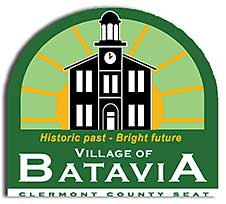 The Clermont Sun is publishing a series of historic vignettes concerning the Village of Batavia pursuant to next year’s bicentennial celebration. Historian Richard Crawford tells here about the school buildings in the village.
The Clermont Sun is publishing a series of historic vignettes concerning the Village of Batavia pursuant to next year’s bicentennial celebration. Historian Richard Crawford tells here about the school buildings in the village.
By Richard Crawford
Public schools in Batavia date to the 19th century. Often, people did not record events in much detail, thinking them unimportant, so much of their history is either lost to time or still to be discovered in old family, church and other archives. Our account here, though incomplete, is from the best sources we have available.
The Broadway school site
The Batavia Board of Education purchased a lot of 2.71 acres in 1871 for $759 to build a school. In February the Board of Education adopted plans for a new building like one in Columbus, Ohio, and employed Columbus architect P.A. Schlapp to draw the plans. On May 10 the board awarded a contract to Joseph Hannold and Robert Jeremiah to erect building. The building contained six classrooms and a large lecture hall, seating 400 people.
The building was brick on a limestone foundation and was trimmed with Ohio River freestone. In the center was a belfry, with a school bell weighing 700 pounds. The total cost was $27,000. The bell now stands in front of the present elementary school building.
On Sept. 22, 1883, the Board of Education voted to buy property to the west of the school, known as the Bell House, from Ashburn and Hulick. This seems to be all of the present school property to the west of the early school. This purchase provided room for a playground and hall field for the school.
In 1915 a $30,000 bond issue was passed to build a high school building on Broadway, construct a sanitary cesspool connected to both buildings and provide concrete walkways. The firm of Robertson and Falmstock drew up plans, and Arthur P. Eveland was the general contractor. An additional $4,000 bond issue was passed to complete the building, which was dedicated on Sept. 9, 1917.
By 1934 the two buildings on Broadway did not provide enough space for the school, but the Great Depression that followed the stock market crash of 1929 was on, and money for construction was hard to get. In 1934 the board decided to seek the aid of the federal government to get the needed school buildings. The architectural firm of Grunkemyer and Sullivan was engaged to draw plans for an addition to the school building. In July of 1935 a $57,000 bond issue was passed, and the board then applied to the federal government for the remainder of the needed money. They received the needed funds from the U.S. Public Works Administration. The oldest building on Broadway was then torn down, and a large addition to the 1915 building was constructed. The courthouse, which is the old wing of the current Clermont County Common Pleas Court, and the bridge on Main Street, since replaced, were also PWA projects.
An industrial arts shop, which now houses an elementary art and music room, was begun in 1941. The start of World War II slowed its construction. It was finished a year later.
By 1948 the population of the school district was growing rapidly. To provide space for expansion, the district bought the Keene property, located just to the east of the schools, for $11,000. The school athletic field was extended to use the Keene property. The house was first rented to a teacher’s family. Home economics classes met on the ground floor later, and classes also met on the second floor after the school district added an outside fire escape.
In January 1953, the Board of Education voted to erect an elementary school on the Keene property. The architectural firm of Garriott and Becker drew up plans for a building, with 12 classrooms and a large recreation room. The board then placed a $364,000 bond issue on the ballot. After it passed by a vote of 387 to 48, in July of that year the board accepted the bid of Arthur P. Eveland, and his company became the general contractor for the project.
When the new high school was built on Bauer Ave. the entire complex on Broadway became the elementary school.
(Next week: The Bauer Avenue school site.)
Richard Crawford, a lifetime student of Clermont County history, has been a journalist for The Clermont Sun and other newspapers. He has written and edited several books of local history.
